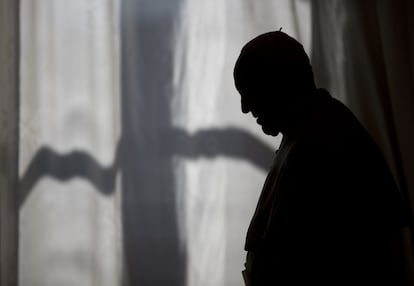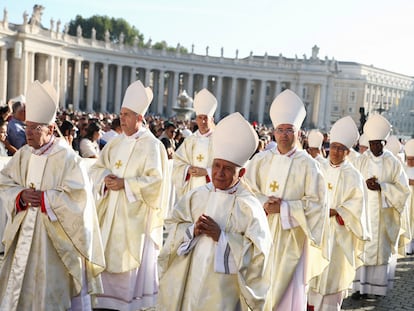The New Testament apocrypha make a comeback of sorts
Pope Francis’s recent actions are sparking renewed interest in writings by early Christians that emphasize the importance of women in the Church

The Roman Catholic Church recently concluded a historic session of the Synod of Bishops which, for the first time, included women empowered to vote. A few months earlier, Frederico Lourenco (University of Coimbra, Portugal) published Evangelhos apócrifos (The Apocryphyal Gospels), a book about writings by early Christians that give accounts of Jesus and his teachings. Called the apocrypha, some of these writings were cited as scripture by early Christians, but a widespread consensus emerged in the 5th century AD limiting the New Testament to the 27 books of the modern canon. The Synod of Bishops convened by Pope Francis addressed once-taboo topics in the Church, including women’s participation in ecclesiastical hierarchy, mandatory celibacy of priests and sexual diversity. Pope Francis has placed significant emphasis on this Synod, which will be held in two sessions one year apart. The first session just concluded and the second session is scheduled for October 2024.
Without a doubt, this Synod marks a break from the traditional conservatism of the Roman Catholic Church, and Pope Francis has openly said he wants to “end Vatican centralism and papal courtiers.” For the first time in Christian history, the role of women in the Roman Catholic Church has gained prominence, with 54 participating in the Synod’s decision-making. To symbolize the spirit of renewal in the Church, the Pope invited 19-year-old Wyalt Olivas, an American university student, to attend.
Interestingly, the new topics discussed in the Synod regarding the active presence of women in the Church have sparked interest in its own origins. The Bible has many examples of women who played prominent roles in the Church, and several, like Mary Magdalene, also appear in the Dead Sea Scrolls (also called the Gnostic Gospels). This collection of early Christian texts discovered in 1945 describe religious ideas and systems in the late 1st century AD among Jewish and early Christian sects.
Pope Francis’s transformative vision (he initially preferred to be known as Bishop of Rome), is prompting a reevaluation of Catholicism’s perspective on the canonical New Testament Gospels of Matthew, Mark, Luke and John. First-century Christians had to contend with dozens of “Gospel” writings that emerged after the death and resurrection of Jesus Christ. Many were deemed apocryphal — of dubious veracity — and declared false centuries later. One such text was called the “Gospel of Mary Magdalene,” the woman to whom Jesus first appeared on the day of his resurrection.
Interestingly, this Gnostic text ascribed to Mary Magdalene is gaining renewed attention these days. The text describes the Apostle Peter asking Mary to share any special teaching by the Savior that only she received. It also contained a passage describing Jesus kissing Mary Magdalene on the mouth, which greatly concerned the Roman Catholic Church, although a kiss on the mouth in Gnostic doctrine represents the transmission of doctrine, not a physical kiss. It’s interesting to how the four Gospels came to be recognized as divinely inspired and included in the Bible, while many other religious and spiritual texts in early Christianity were excluded.
Following the recent, groundbreaking Synod, there has been a resurgence of interest in the so-called apocryphal gospels since they highlight the presence and significance of women in the early Church. In an interview with Brazilian newspaper O Globo, Frederico Lourenco said, “The difference between these writings and the four canonical gospels — Matthew, Mark, Luke and John — is very clear. Not only do the apocryphal texts use more straightforward language, but they also convey an almost subversive and openly feminist message that values the role and autonomy of women in Christianity.” As expected, Pope Francis’s effort to address the role of women in the Catholic Church has sparked renewed debate on the apocrypha.
Curiously, much lore about the birth, childhood, death and resurrection of Jesus do not appear in the four Gospels. Like the names of the three wise men — Melchior, Gaspar and Baltasar — and many details of the virgin birth of Jesus. There are over a million books about the Christian Gospels and their interpretation, yet not much is known about how and why many texts were deemed apocryphal after four centuries and excluded from the Bible we know today. How did the Church determine which writings were inspired by God and which were seen as false or anonymous? Some skeptics point to unexplained differences and apparent contradictions in the four Gospels and say they were likely derived from the apocrypha.
In my own book, Jesús, ese gran desconocido (Jesus, the great unknown), I offer some explanations for how the four Gospels were deemed to be inspired by God and included in the canonical New Testament. These reasons highlight the challenges the fourth-century Church faced in rejecting many of the writings that had been used by clergy for several centuries. The four Gospels were selected from a group of about 60 texts. Saint Irenaeus, explained it this way in the year 205. “The Gospel message stands as the pillar of the Church, which, in turn, stretches across the globe. As the world is divided into four regions, it is fitting that there are precisely four Gospels.”
The First Council of Nicaea (near Iznik, Turkey) was a council of Christian bishops convened by the Roman Emperor Constantine I in AD 325 to attain consensus in the Church. Libellus Synodicus, an anonymous, pseudo-historical book of early Christianity with information on synods and ecumenical councils, says that all the scriptures approved by God miraculously appeared on the Council’s altar, proof of their divine inspiration. Another account is that all the scriptures were placed on the altar and the apocrypha fell to the ground, while the divinely inspired writings remained in place. Yet another said that the Holy Spirit manifested in the form of a dove at the Council of Nicaea, gracefully passing through a glass window without breaking it. The dove perched on the shoulder of each bishop, whispering into their ears the names of the four Gospels inspired by God.
The truth is, it took time for the Church to acknowledge that the four canonical Gospels were not strictly historical accounts, but rather theological material. They are now better examined in the context of the Gnostic writings. Pope Francis, a trailblazer in recognizing and honoring the vital role of women in the transition from Judaism to Christianity, is revitalizing — perhaps unintentionally — the significance of those often overlooked apocrypha that underscore the impact of women within the Church.
Sign up for our weekly newsletter to get more English-language news coverage from EL PAÍS USA Edition
Tu suscripción se está usando en otro dispositivo
¿Quieres añadir otro usuario a tu suscripción?
Si continúas leyendo en este dispositivo, no se podrá leer en el otro.
FlechaTu suscripción se está usando en otro dispositivo y solo puedes acceder a EL PAÍS desde un dispositivo a la vez.
Si quieres compartir tu cuenta, cambia tu suscripción a la modalidad Premium, así podrás añadir otro usuario. Cada uno accederá con su propia cuenta de email, lo que os permitirá personalizar vuestra experiencia en EL PAÍS.
¿Tienes una suscripción de empresa? Accede aquí para contratar más cuentas.
En el caso de no saber quién está usando tu cuenta, te recomendamos cambiar tu contraseña aquí.
Si decides continuar compartiendo tu cuenta, este mensaje se mostrará en tu dispositivo y en el de la otra persona que está usando tu cuenta de forma indefinida, afectando a tu experiencia de lectura. Puedes consultar aquí los términos y condiciones de la suscripción digital.
More information
Archived In
Últimas noticias
Most viewed
- Reinhard Genzel, Nobel laureate in physics: ‘One-minute videos will never give you the truth’
- Oona Chaplin: ‘I told James Cameron that I was living in a treehouse and starting a permaculture project with a friend’
- Pablo Escobar’s hippos: A serious environmental problem, 40 years on
- Why we lost the habit of sleeping in two segments and how that changed our sense of time
- Chevy Chase, the beloved comedian who was a monster off camera: ‘Not everyone hated him, just the people who’ve worked with him’











































